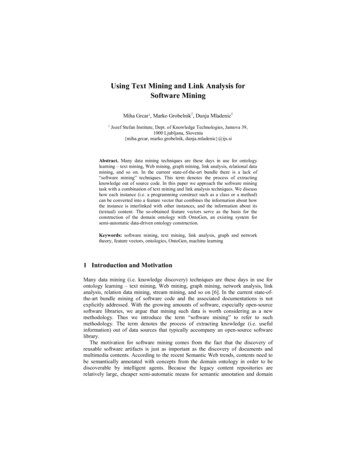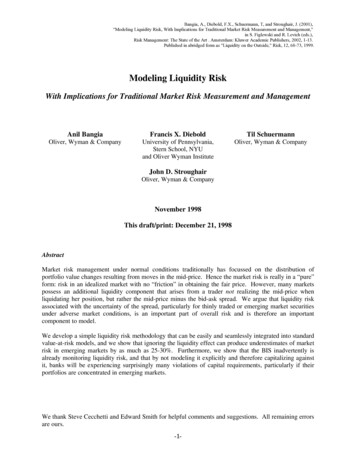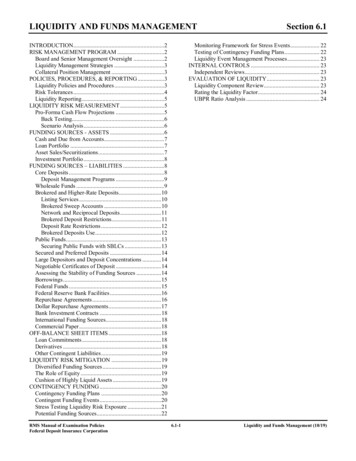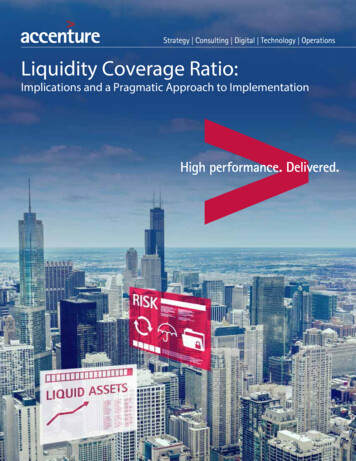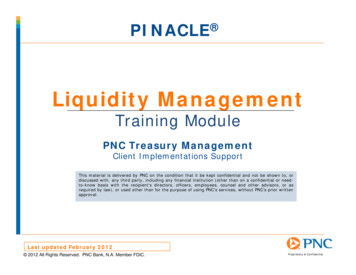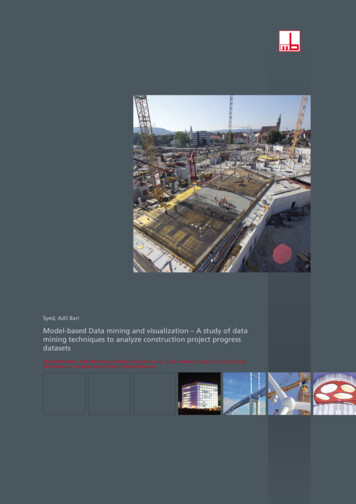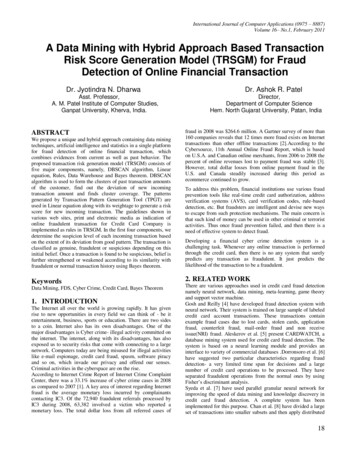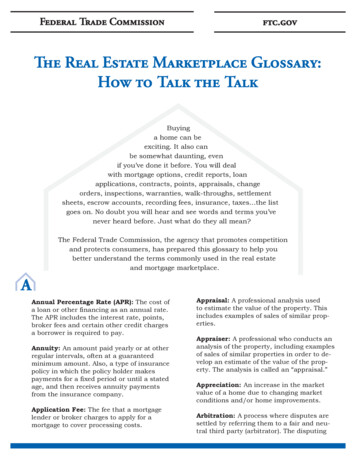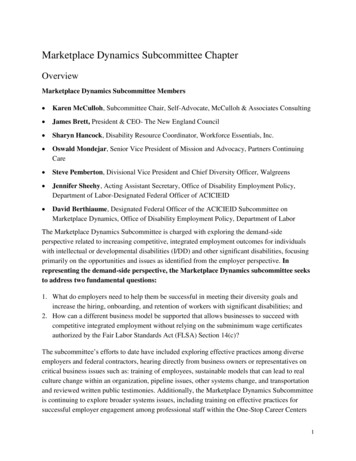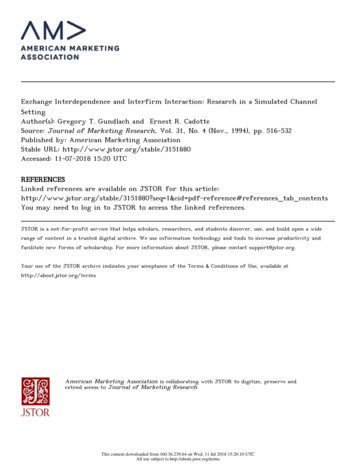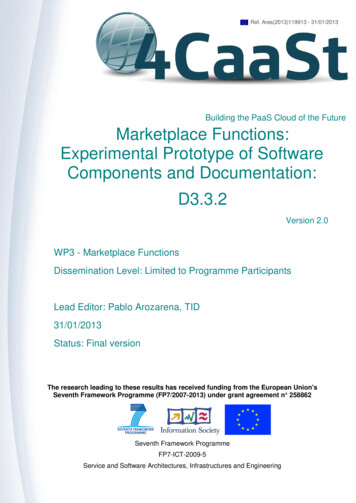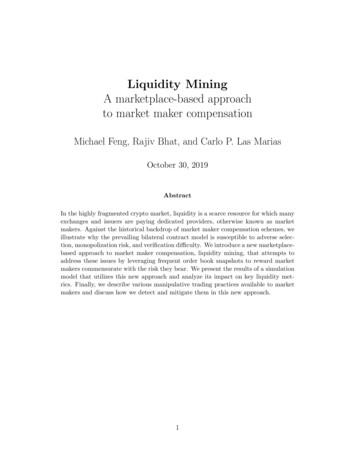
Transcription
Liquidity MiningA marketplace-based approachto market maker compensationMichael Feng, Rajiv Bhat, and Carlo P. Las MariasOctober 30, 2019AbstractIn the highly fragmented crypto market, liquidity is a scarce resource for which manyexchanges and issuers are paying dedicated providers, otherwise known as marketmakers. Against the historical backdrop of market maker compensation schemes, weillustrate why the prevailing bilateral contract model is susceptible to adverse selection, monopolization risk, and verification difficulty. We introduce a new marketplacebased approach to market maker compensation, liquidity mining, that attempts toaddress these issues by leveraging frequent order book snapshots to reward marketmakers commensurate with the risk they bear. We present the results of a simulationmodel that utilizes this new approach and analyze its impact on key liquidity metrics. Finally, we describe various manipulative trading practices available to marketmakers and discuss how we detect and mitigate them in this new approach.1
Contents1 INTRODUCTION42 BACKGROUND62.1What Market Makers Do . . . . . . . . . . . . . . . . . . . . . . . . . . . .62.2History of Market Makers . . . . . . . . . . . . . . . . . . . . . . . . . . .72.3Compensating Market Makers . . . . . . . . . . . . . . . . . . . . . . . . .82.3.1Should Market Makers be Compensated? . . . . . . . . . . . . . . .82.3.2Methods of Compensation . . . . . . . . . . . . . . . . . . . . . . .9Problems with Status Quo . . . . . . . . . . . . . . . . . . . . . . . . . . .112.4.1Adverse Selection . . . . . . . . . . . . . . . . . . . . . . . . . . . .112.4.2Monopolization Risk . . . . . . . . . . . . . . . . . . . . . . . . . .122.4.3Verification Difficulty . . . . . . . . . . . . . . . . . . . . . . . . . .122.43 MARKETPLACE DESIGN143.1Overview . . . . . . . . . . . . . . . . . . . . . . . . . . . . . . . . . . . . .143.2Market Participants . . . . . . . . . . . . . . . . . . . . . . . . . . . . . . .143.3Measuring Liquidity . . . . . . . . . . . . . . . . . . . . . . . . . . . . . .153.4Liquidity Mining Model . . . . . . . . . . . . . . . . . . . . . . . . . . . .163.4.1Order Book Snapshots . . . . . . . . . . . . . . . . . . . . . . . . .173.4.2Spread Density Function . . . . . . . . . . . . . . . . . . . . . . . .183.4.3Budget Allocation. . . . . . . . . . . . . . . . . . . . . . . . . . .19Simulation-Based Analysis . . . . . . . . . . . . . . . . . . . . . . . . . . .203.5.1203.5Assumptions . . . . . . . . . . . . . . . . . . . . . . . . . . . . . . .2
3.5.2Results . . . . . . . . . . . . . . . . . . . . . . . . . . . . . . . . . .4 PREVENTING MANIPULATION21254.1Manipulation in Crypto . . . . . . . . . . . . . . . . . . . . . . . . . . . .254.2Types of Manipulation . . . . . . . . . . . . . . . . . . . . . . . . . . . . .254.2.1Wash Trading . . . . . . . . . . . . . . . . . . . . . . . . . . . . . .264.2.2Spoofing . . . . . . . . . . . . . . . . . . . . . . . . . . . . . . . . .264.2.3Price Manipulation . . . . . . . . . . . . . . . . . . . . . . . . . . .284.3Data Collection and Verification . . . . . . . . . . . . . . . . . . . . . . . .284.4Auditability . . . . . . . . . . . . . . . . . . . . . . . . . . . . . . . . . . .295 SUMMARY303
1INTRODUCTIONLiquidity is an important metric for all financial assets and trading venues. However, manymarket participants are unclear as to what drives liquidity and how to measure its effects.This is because market making, the business of providing liquidity, has traditionally beenaccessible to only a limited number of participants, such as quantitative hedge funds andtrading desks of large financial institutions.In the original Hummingbot whitepaper[1], we described how direct market access, a uniquefeature of the digital assets (crypto) market, enables anyone to be a market maker, as wellas the rationale for why individuals may be better positioned than professional firms toprovide liquidity for certain markets and assets. We also discussed how open source softwarecould provide both individuals and firms the tooling needed to run high-frequency marketmaking strategies.However, while Hummingbot as a technical solution enables a wider set of market participants, it by itself does not solve the generalized problem of liquidity fragmentation in thecrypto market. Today, crypto exchanges and token issuers spend an estimated 1.2 billionper year compensating market makers, typically quantitative hedge funds that specializein crypto assets, in the form of rebates, fees, and opportunity cost of lent inventory. Inaddition, the long tail1 of exchanges and token issuers cannot afford to hire a hedge fundand therefore cannot attain the requisite liquidity for their markets to function.In contrast to the many technological and economic breakthroughs that the digital assetsindustry has innovated, there has been comparatively little innovation in how market makers are compensated. As in fiat markets, crypto exchanges and token issuers enter intobilateral contracts with market making firms that base compensation upon long-term commitments to provide predefined levels of liquidity, as measured by order uptime, spread,and volume. Not only do these bilateral contracts inflate coordination costs that reducematching efficiency, they also introduce adverse selection and monopolization risks thatdiminish the effectiveness of the compensation provided.Instead, we believe that a marketplace-based approach, inspired by two-sided digital marketplaces in other industries like transportation and online advertising, can promote consistent liquidity provision, mitigate the risk of manipulative practices, and improve matchingefficiency in the market for liquidity.In Section 2: Background, we discuss the role and history of market makers and explainwhy and how they have been compensated in both traditional and digital markets. Then,we outline why today’s prevailing market maker compensation schemes are sub-optimal.1As of October 2019, there are 2,970 digital assets, 285 digital asset exchanges, and 20,867 uniquemarkets tracked by CoinMarketCap (https://coinmarketcap.com).4
In Section 3: Marketplace Design, we introduce a new marketplace-based approach tomarket maker compensation that leverages competitive dynamics to align rewards earnedby market makers with risks that they bear in different market regimes. In addition, weintroduce an open, pay-as-you-go marketplace structure that aims to reduce coordinationcosts and improve matching efficiency between liquidity buyers and sellers.In Section 4: Preventing Manipulation, we describe how the design of the LiquidityMining marketplace, along with surveillance and detection algorithms, disincentivize anddeter manipulative trading practices.5
22.1BACKGROUNDWhat Market Makers DoIn a seminal 1968 paper, Harold Demsetz identifies the lack of “predictable immediacyof exchange in financial markets”[2] as a fundamental trading problem, which is similarto what economists today term coincidence of wants. Because buyers and sellers are notsynchronized, a buyer arriving at a market may not find a seller who agrees to transact ata suitable price and quantity, and vice versa. Demsetz writes that the regular presence ofmarket makers, who fill gaps from asynchronous order arrival, can mitigate this problem.Market makers have been long recognized as an important component of financial markets.“Were it not for this intermediary class. . . the public would experience great delay andinconvenience in their sales or purchases of stock”[3] wrote Henry Keyser in 1850 aboutmarket makers in the world’s first stock exchange, the Amsterdam market for Dutch EastIndia Company Shares.The job of a market maker is to place and adjust limit orders on an exchange’s order book,i.e. binding offers to buy and sell a specific quantity for a specific price. Effectively, marketmakers provide free options to the market, where each option is the right to buy or sellfrom them, and aim to profit from the differential between buy and sell prices.Exchanges and market makers have a symbiotic relationship: an exchange provides thevenue where traders go to execute trades, while market makers provide the liquidity thatensures traders can transact efficiently. “Electronic platforms are merely the oil that greasesthe engine. They do not provide liquidity. For that, you still need market makers who canmake prices and take risk”[4].Capital is a key constraint for market makers: the act of utilizing capital to place orders onone market precludes a market maker from re-using that capital in another market. Sincemost exchanges force market makers to deposit capital into their accounts before they canplace orders, the process of transferring capital from one exchange to another can also exacthigh transaction costs and inefficiencies on market makers.Since market makers have to commit capital to specific financial markets in order to provideliquidity to them, financial markets essentially compete with one another on the basisof liquidity. The joint SEC-CFTC task force investigating the May 2010 Flash Crashwrote, ”Liquidity in a high-speed world is not a given: market design and market structuremust ensure that liquidity provision arises continuously in a highly fragmented, highlyinterconnected trading environment”[5].6
2.2History of Market MakersIn the United States, market making for securities is a highly regulated activity. All firmsthat make markets for securities must register with Financial Industry Regulatory Authority (FINRA). This circumstance arose because the original market makers in US equitymarkets were exclusively broker-dealers, a dual role that combines fiduciary responsibilitiesto trade on behalf of clients (in the broker capacity) and profit-seeking opportunities totrade for one’s own account (in the dealer capacity).While these broker-dealers played a vital role in providing the liquidity necessary for earlyvenues such as the New York Stock Exchange (NYSE) to function, their dual principal/agent role gave rise to potential conflicts of interest that concerned regulators. InHarold Bloomenthal’s classic 1971 paper about market making, he wrote, “The close relationship that may develop between the company and dealer under these circumstances isillustrated by the not atypical remark of one dealer that ‘virtually every aspect of the company’s operations were discussed with me.’ The situation seeps with potential for securitiesviolations.”).[6].As a result, regulations that constrained what market makers could do and how they couldbe compensated sprang as a direct byproduct of these risks, “not because all market-makersare manipulators engaged in a shell game, but because there are sufficient numbers soengaged to give rise to concern about the integrity of the markets in many securities.”[6].Today, market making for securities remains a highly regulated industry in the UnitedStates, and until recently, direct market maker compensation was disallowed.Instead of direct monetary compensation, market makers were compensated indirectly. Inexchange for standing ready to provide liquidity, NYSE specialists received advantagesrelated to time, place, and information (see Methods of Compensation: Indirect Compensation below). In other venues, “the market maker is often the executor of the listed firm’sinvestment banking ventures, which indirectly subsidizes the market making business”[7].In recent years, fragmentation and electronification of financial markets have exacerbatedthe importance of liquidity and the need for market makers. Whereas U.S. equities weredominated by a few large exchanges, today there are 13 equities exchanges and 55 Alternative Trading Systems[8] registered with the SEC. In the digital assets markets, there are2,980 individual cryptocurrencies that trade on hundreds of different exchanges, resultingin 20,903 unique markets[9].Unlike the NYSE which only gave seat-holders the right to trade shares on the exchange2 ,these new venues sourced liquidity from the growing number of high-frequency trading(HFT) firms that engage in market making as a pure principal business. “The traditionalapproach to regulating the specialist system on securities exchanges was founded on the2In 2005, NYSE also relented and allowed non-seat holders to trade on the exchange.7
dual role of these market participants as dealers and order-matching agents, and the recentevolution of securities markets has led to the ‘de-agentization’ of market makers, therebydissolving the old paradigm”[10].The 1990s rise of electronic trading and fragmentation of the exchange industry challengedprior models which eschewed compensation in favor of regulations and access control. Newlyestablished venues introduced innovations such as the maker-taker pricing model and otherindirect compensation methods in order to attract liquidity.The fragmentation of liquidity across the exchange landscape also caused significant problems for smaller-cap stocks: “The unintended consequences of that market fragmentationhave been a lack of liquidity and price discovery in listed securities outside of the top 100traded names and a disturbing absence of market attention paid to small-growth companies by all market participants, including exchanges”[11]. These liquidity issues gave rise toexperiments with direct market maker compensation by European stock exchanges and byNasdaq with its Market Quality Program for ETF issuers (see Methods of Compensation:Direct Compensation below).Today, market making in modern financial markets is dominated by HFT firms like TwoSigma, Jump Trading, and DRW Cumberland who take profitability, rebates, risk, andother factors into account when deciding where to provide liquidity.2.3Compensating Market MakersIn both traditional and digital markets, direct and indirect market maker compensationarrangements are commonplace. Indirect compensation generally takes the
A marketplace-based approach to market maker compensation Michael Feng, Rajiv Bhat, and Carlo P. Las Marias October 30, 2019 Abstract In the highly fragmented crypto market, liquidity is a scarce resource for which many exchanges and issuers are paying dedicated providers, otherwise known as market makers. Against the historical backdrop of market maker compensation schemes, we illustrate
